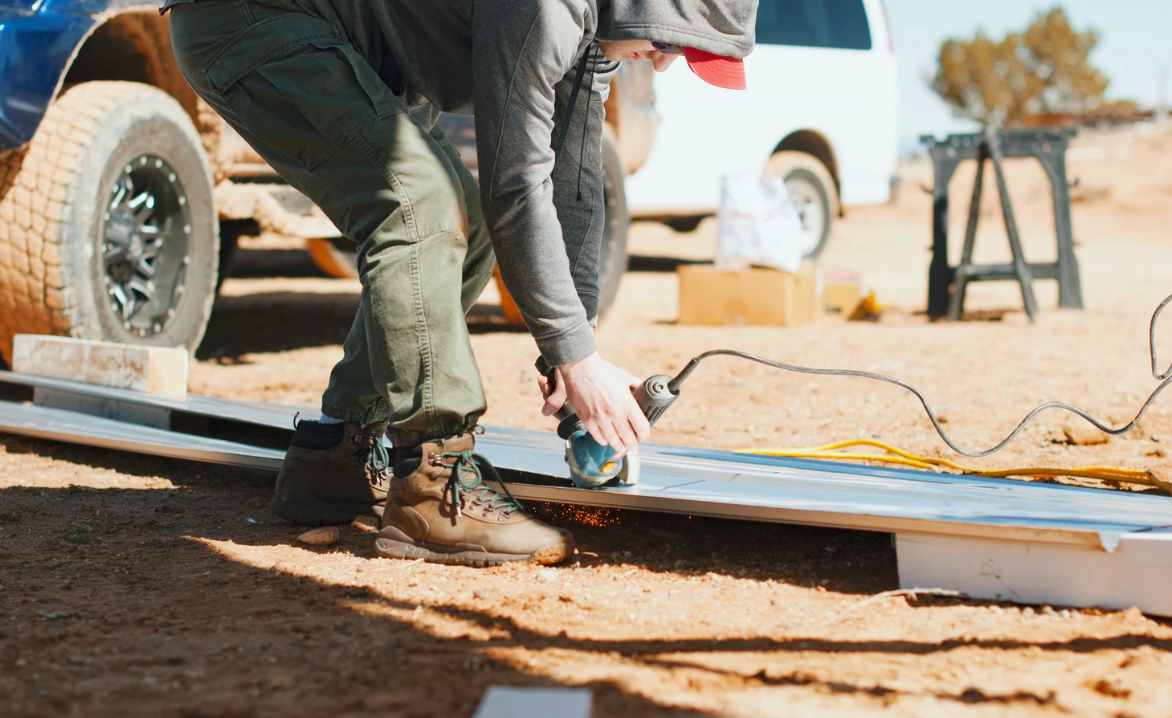Gutting any home, even a mobile home, can be a daunting task. The work can be a challenge and will be intensive, and in some cases, it may not be worth the cost. For this reason, people often see it as a last resort.
But if done right, gutting your home can help you reap substantial rewards on more than one level.

Whatever your reason for gutting, knowledge is key to approaching the process safely and effectively. So here is a full guide to gutting a mobile home.
What does gutting a mobile home involve?
A full gut involves stripping away most of a building until there is only a structural skeleton left. This means that only the metal or timber frame and studs will still be standing. Generally, the job is quite extensive and involves stripping away the following:
- Siding
- Paneling
- Roof membrane
- Windows
- Stairs
- Roof tiles
- Ceiling
- Interior finishes
- Flooring
- Drywall
- Built-in cabinets and furniture
- Plumbing and wiring
- Heating and other systems
Once you’ve done this, you have several options for what to do with the structure and its parts. First, you might be able to reuse or possibly resell some of the interior fixtures like the cabinets. Otherwise, if items are not salvageable, you may be able to sell them for scrap.
In the end, you can also usually scrap or destroy the frame, too (if you decide not to rebuild, that is). Luckily, many of the materials in these structures are recyclable, so this can be an eco-friendly solution.
Otherwise, you can reuse the home’s skeleton and basically build a new mobile home for yourself from scratch. This will allow you to do a complete remodel of the property.
However, it doesn’t always have to be as extensive as we’ve just described. In some cases, people only need to do a partial “gut,” removing only some parts. You will usually do this if these parts are still in a suitable condition, if your budget doesn’t allow a full gut, or if your renovation is only a small-scale one.
When is it time to “gut” a mobile home?
Gutting a mobile home is quite a job, so it’s not a decision that you should take lightly. However, because these homes are modular, the task can be easier than a gut of a site-built property.
In the end, you have to decide whether you can get anything of value out of the home after gutting. And you need to weigh whether the home is salvageable at all and whether you should instead demolish it in its entirety.
Here are the primary reasons for gutting a mobile home:
- The building is no longer up to the standards of the HUD code or is a pre-1976 model.
- Not all dumpsites will allow you to dump an entire mobile home, so you need to deconstruct it first.
- You need to move, and the mobile home is not road worthy.
- Damage to the property might be so extensive that it’s not worth trying to repair.
- You want to or need to do a complete renovation of the mobile home.
- It has exceeded its life expectancy. Generally, these structures have a life expectancy of 30 to 55 years. And if your home is older than this, it might be time to strip it down.
Before you make any binding decisions, we recommend that you discuss your specific case with a contractor or other demolition expert first. He can advise you on the complexity of the process, the costs, and the expected timeline. Above all, he can help you assess whether it’s viable and worth it.
Call in the experts or DIY?
The all-important question: should you attempt the deconstruction yourself? Or is it better to call in the experts?
To make the right decision, you should take into account the complexity of the job, the cost, and whether you require any specific permits or licenses.
Taking apart a mobile home is usually far easier than taking apart a traditional home. So you should be capable of handling the task yourself as long as you have a friend or two to help.
However, there will still be costs involved. First, you will need to rent a trailer to haul away the scrap and debris afterward. And you might also need to rent or buy some tools. All of this together can set you back between $800 and $2,000.
On top of this, you will need to apply and pay for a deconstruction permit that typically costs around $200. Depending on your location, you might also need additional licenses, especially for selling scrap.
On the other hand, contractors will generally have a rate of $4 to $16 per square foot. They might also charge you extra for removing the scrap and materials.

Therefore, for gutting a 1,000-square-foot single wide, experts might ask you between $4,000 and $16,000. So you should ask around for quotes.
And make sure to double-check what exactly they provide for their quoted prices. This will help you compare your options more accurately.
The process of gutting a mobile home
Whether you decide to DIY the deconstruction or hire a contractor, it can be useful to understand more about the process. The order of the steps may vary from case to case. But generally, this is a sound guide to follow.
1 – Research
Before you get your hands dirty, you need to do some research first. It will mostly involve finding out what your options are and making sure you use them to their full advantage. But you should also make sure that you are following all the necessary legal procedures.
That’s why you should do some detective work on the following points:
- Worth of different scrap material
- Required permits and licenses
- People or organizations who will buy your scrap
- How to transport the debris
- Location of nearby dumpsites
- Nearby recycling firms
- Services offered by local contractors
- Temporary storage services if needed.
2 – Getting the right gear and supplies
Next, you need to prepare for the job at hand. This means you have to gather all the equipment you will need.
Sort out the safety gear first. You should use similar personal protective equipment (PPE) to that used on construction sites. For example:
- N95 respirator
- Safety glasses
- Hard hat
- Heavy-duty boots
- Gloves
- Long sleeve shirt and long pants
Make sure that you have enough gear for everyone who will be working on the home.
In terms of tools, you will need the following at least:
- Standard size hammer
- Sledgehammer
- Crowbar
- Saw
- Utility knife
- Trash bags
- Ladder
- Paint scraper
- Screwdrivers
- Adjustable wrench
3 – Rent a trailer
Part of the preparation involves renting a trailer (to haul away the debris) and ensuring you have access to a vehicle that can pull it. You can either rent it beforehand so that you can start loading it as you work or you can get one afterward.
4 – Shut off utilities
When you’re ready to start, you need to turn off (and, if necessary, disconnect) all the utilities that are connected to the mobile home. This includes shutting off the power, gas, and all of the water and plumbing.
To do this, you need to send a notice to the utility companies. They will then shut them off and send a technician to disconnect each of the services from the building. Make sure to ask them for verification that this has been done.
Remember, safety first.
5 – Clear out the mobile home
Next, you want to remove everything that isn’t nailed down (and some things that are) from inside the home. For example, take out all your furniture, appliances, and wall hangings.
First focus on the items you want to keep.
We recommend that you create different piles for your things from the start. You should have one pile each for the following categories: thigs you want to keep, donations, things you can resell, scrap, recyclables, and trash. Trust us. This will make the cleanup process far more organized.
6 – Uninstall fixtures
Once this is done, you need to remove all the fixtures from the mobile home. Again it’s a good idea to start with the items you want to keep – for example, a valuable light fixture or your favorite set of cabinets.
By this time, everyone involved should be wearing protective equipment and gear.

In this step, you want to take out things like the following:
- Light fixtures
- Cabinets
- Shelves
- Trim
- Windows
- Doors
- Fans
- Air conditioners
Besides this, it’s also time to remove or break out any visible PVC pipes in your bathroom, kitchen, laundry room, and other areas.
7 – Pull up the flooring
Now, you should be able to start removing all the flooring in the home.
First, you should get rid of any tacks that are securing the flooring to the surface beneath. When you’ve done this, you should start pulling up the flooring from the corner.
Generally, you need to pull up any laminate or plywood materials piece by piece. You can sometimes pull up a carpet in one go. But it’s more manageable if you cut the carpet into strips first and roll them up as you go.
The most difficult flooring to remove is usually ceramic tiles. In most cases, you will need to break them.
8 – Remove the roof
Dismantling the roof can potentially be the most dangerous part of the deconstruction. Here you will definitely need someone to hold the ladder for you. It can also be handy to have someone that you can pass the pieces to.
This step can get messy, so lay down tarps on anything around or inside the house that you want to protect.
The process will differ depending on the type of roof. You should start by dismantling the shingles or other type of cover first. Take out any fasteners that are holding them in place and pay attention to take off the overlapping tiles first.
Afterward, you can cut out the ice and water barrier.
As you start deconstructing sections, keep in mind that you will need an area to sit or stand on as you do the work. Also, keep in mind that the stability of the roof will probably decrease as you remove more and more pieces.
9 – Dismantle the walls and ceiling
From here, you can move on to removing the walls and ceiling.
It often works best to start with the paneling inside the mobile home. Pull out any fasteners and then remove individual panels from the top and work your way downwards.
You will follow a similar process for taking out any drywall. But here you work from the bottom up by prying the sheets loose.
Once you’re done inside, you can repeat the process with the siding on the exterior of the home.
When it comes to the ceiling, you will also remove any fasteners first and then start removing the ceiling, section by section, starting in a corner.
10 – Safely remove wiring and plumbing
This step is optional. You might not want to do it if you are not planning to gut the structure completely – and if your wiring and plumbing are still in good order.
However, if you want to deconstruct the home in its entirety, you will have to take these elements out. Overall, this will probably be the trickiest part of your deconstruction project. Many homeowners choose to consult experts to assist them in this task.
But, if you want to do it yourself, remember to study the plan so that you can find out where all the wires and pipes are situated.
11 – Haul away the rest
Now you will be left with all the different parts of what used to be your mobile home. You will need to use a trailer to haul everything away to its respective destination (scrapyards, for instance, or recycling facilities). Or you can hire a specialized company to take these things away for you.
Unfortunately, normal garbage disposal services will not deal with this type of building rubble.

12 – Deal with the frame
Finally, you will be left with only the frame. If you want to, you could easily cut it into smaller sections and sell those as scrap. Sometimes a scrapyard owner will buy the whole skeleton, as is.
Otherwise, you can build up a new home around the frame. Look at it as a blank canvas that you get to fill.
Start with a clean slate
Gutting a mobile home gives you the chance to really get a fresh start. The process involves a lot of hard work and organization. But in the end, it can also offer many opportunities. Above all, it can allow you the chance to design the mobile home of your dreams.
Finally, you will be able to make extensive changes such as turning the floor plan into an open concept or increasing the natural lighting in your mobile home significantly.


